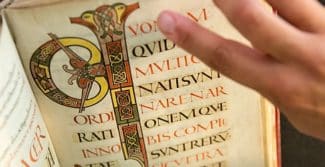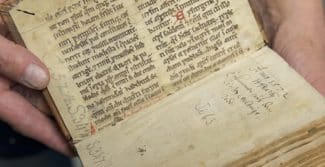11 June 2024
Schreibkalender are to be considered one of the most popular media products of the period. From 1540 onwards, these almanacs or calendars were a characteristic part of the contemporary media ensemble. Schreibkalender are calendars in book form (usually in quarto), causing readers to approach the printed pages from left to right. The term “Schreibkalender” was contemporary—a prominently placed marker in the calendar series titles.
Like other printed almanacs of early modern Europe, almost all writing calendar series were produced in large quantities and reached massive audiences. Considering the known numbers of calendar copies published, writing calendars seem likely to have been amongst the highest produced, sold, and consumed printed artefact of the period. This is almost certainly the case amongst the output of the print industries in German-speaking Europe. As Helga Meise states in her work Das archivierte Ich: Schreibkalender und höfische Repräsentation in Hessen-Darmstadt 1624–1790 (Darmstadt 2002), Schreibkalender were the third most printed genre around the year 1600, only outsold by the Bible and the catechism.
Due to yet missing data, a precise calculation of the total number of copies produced annually in the German territories should be approached cautiously. Nevertheless, it seems justified to suggest that many of these ten thousand copies reached more eyes than only those of their buyers. The evidence and estimated calculations of the total number of copies published for each writing calendar series within Germany, combined with the suggestions regarding the audiences reached by early modern printed products, leads to a single conclusion: writing calendar series must be considered as one of the most popular media products of the period. In fact, writing calendar titles addressed explicitly students, merchants, lawyers, medical doctors, scientists, office workers, but also craftsmen and military men to use them.
Like all calendars, writing calendars too were designed to offer seasonal and temporal orientation, as well as education on many topics including but not limited to celestial configurations and planetary positions or events, information on movable feasts and other important days of the year, practical instructions for daily life, and matters of entertainment.
A writing calendar consisted of two parts, the Calendarium and the Prognosticum. At the beginning of the genre in the sixteenth century these parts were usually sold separately. However, from the seventeenth-century onwards, the Calendarium and the Prognosticum were typically bound together and sold as one printed product. In the Calendarium, the first portion of the writing calendar, the almanac-maker (in German: Kalendermacher) presented carefully calculated monthly tables containing astronomical information and astrological details for that calendar year following either (or sometimes both) the Julian and Gregorian calendar systems. These calculations were often enriched with explanations by the calendar-makers about their background and about which scholars’ planetary tables they were using; the usage of special signs—including symbolic and figural imagery in the representation of the various astronomical, astrological, and religious data—was also positioned in the Calendarium, generally on the left-hand pages. While some Schreibkalender series and copies explained the signs, symbols, figures, and abbreviations used, other writing calendars neglected to provide this service at all or did so only in parts. The Erfurt-printed “Alt und New Schreibkalender Auff das Jahr/ … M.DC.XIII.,” for example, had a section on the meaning of the signs used within the content (“Bedeutung der Characteren und Zeichen So in diesem Calender gebraucht werden)” on the first page of the Calendarium.
Here, the zodiac signs and planetary signs were explained, as well as additional symbols used to denote the weather, good days for bloodletting, and for activities such as planting seeds, meeting friends, or the cutting of timber or hair.
The Prognosticum, the second part of the writing calendar that was sometimes also called “Practica,” contained astrological predictions and advice for the upcoming year about weather conditions and patterns based on the planetary alignments for the four seasons, harvest issues, diseases and cures, and dangers in potential war times. In this part the explanations of the eclipses were also featured, and often also longer stories on historical, political, and religious topics were included. Being originally a medical term, the word “prognostication” had, from the fifteenth century onward, a notion of foretelling, and prediction of a future event, but in almanacs it was pragmatically used to denote an astrometeological forecast for the year. In this sense, the Prognosticum of the German Schreibkalender complimented the data of the calendarium in first part by providing enriched and enhanced calendrical information plus selected and curated news stories.
So why should you use writing calendars in your research?
The answer to this is easy, as more than one third of the known surviving copies of writing calendars up to the year 1800 contain handwritten traces. In the database we are building for Schreibkalender with handwritten traces (see: https://schreibkalender.wisski.data.fau.de ), thousands of these almanacs are documented and become eventually visible for historical research. More than 6,000 of the approximately 15,000 known copies offer historians many and varied rich sources of departures, as the writing calendar copies document usages by a great variety of individuals and professions. Among the known users were, since 1541, scholars and students, merchants, military officers and soldiers, theologians, wardens (“Hausväter”), medical doctors, lawyers, all kinds of authorities (from princes to members of city councils), clerks, as well as craftsmen and farmers. In short: whatever you are looking for might be written down in a copy of a Schreibkalender.
In addition to these handwritten comments, the genre itself is becoming a focus too. As the research on writing calendars—and on early modern calendars in general—has recently embarked upon new ground with important (bio-)bibliographical work and a closer connection to the fields of media and book history, the futures of historical almanac research will likely be written as part of a communication history of early modern Europe.
Literature:
Daniel Bellingradt: “The early modern German Schreibkalender: a printed publication made for handwritten interaction,” in: Falk Eisermann / Jacob Baxter (Hg.): Print and Manuscript (forthcoming).
Klaus-Dieter Herbst: Biobibliographisches Handbuch der Kalendermacher. 4 vols. (Jena: Verlag HKD 2020)
Cover image: Title page Alter und Newer Schreibkalender mit ordentlicher Verzeichniß der gewönlichen Erwehlungen for 1604 from Burkhard Victorin Schönfeld, printed by Johann Beck in Erfurt (copy in Stadtarchiv Mühlhausen, Sig. 80/1261,6(K)). UrMEL: https://zs.thulb.uni-jena.de/receive/jportal_jpvolume_00281207
Der Autor
Prof. Dr. Daniel Bellingradt ist Historiker und Buch- sowie Kommunikationswissenschaftler. Zur Zeit ist er Gastprofessor am Institut für Europäische Kulturgeschichte der Universität Augsburg. Im März 2024 leitete er gemeinsam mit Dr. Klaus-Dieter Herbst die an der Herzog August Bibliothek stattfindende Tagung „Die Schreibkalender der Frühen Neuzeit und die Handschriften in ihnen“.
Zur Person











